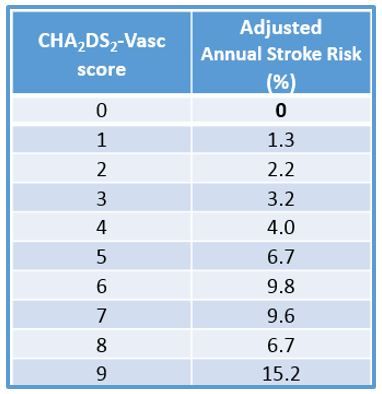- Clinical Technology
- Adult Immunization
- Hepatology
- Pediatric Immunization
- Screening
- Psychiatry
- Allergy
- Women's Health
- Cardiology
- Pediatrics
- Dermatology
- Endocrinology
- Pain Management
- Gastroenterology
- Infectious Disease
- Obesity Medicine
- Rheumatology
- Nephrology
- Neurology
- Pulmonology
New Afib Scoring System: Is it New or Just Different?
The popular CHA2DS2-Vasc stroke risk calculator has its detractors. But will a newly proposed scoring system have a significant clinical impact?

Figure 1. (Please click to enlarge) Adapted from A-Hamid I, et al. J Am Coll Cardiol. 2018;71:334.

There was a dramatic increase in the use of oral anticoagulation several years ago when use of the CHA2DS2 stroke risk prediction rule became commonplace in clinical practice. It was revised a few years later to improve risk prediction with the addition of the “Vasc” (for vascular disease, eg, PAD, MI, plaque) component. Now, it is the number one guideline-endorsed way to predict thromboembolic risk in atrial fibrillation and determine whether oral anticoagulants should be used. Yet, it has some limitation and continues to draw criticism.
For example, there is evidence that it underestimates risk when applied to the Danish National Patient Registry and is inaccurate at scores above 6 (decreasing stroke rate). Furthermore, it does not change with interventions that alter stroke risk (eg, anticoagulation). In addition, with a CHA2DS2-Vasc score of 0, predicted stroke risk is nearly 0%, which is known to be inaccurate. And finally, a table (or memorization) is required to correlate the score with the predicted stroke risk. See Figure 1 above (please click image to enlarge).
Next: A new approach
A new approach
At the American College of Cardiology 2018 Scientific Sessions, researchers presented a new scoring system for atrial fibrillation that addressed many of these limitations, abbreviated as: A2FIBS2+PAF+0.8
A2FIBS2+PAF+0.8
A Age ≥75y (2 points)
F Heart failure
I Insulin deficiency or DM
B BP or HTN
S Prior stroke or TIA (2 points)
P Plaque of aorta, prior MI, PAD
A Age 65 to 74y (do not add any points for this if age ≥75y)
F Female gender
Minimum score without modifiers = 0.8% Maximum score without modifiers = 9.8%
Each value gets a single point and age ≥75 years and prior stroke/TIA are multiplied by 2 or get 2 points each. The scoring system is multiplied by X if there is an intervention or other lifestyle factor that predicts stroke risk. For example, initiation of oral anticoagulation results in multiplication by a fraction of 1 (the amount of relative risk reduction of that anticoagulant). Conversely, smoking or excess alcohol use, which are known to increase stroke risk, result in multiplication of the score by a factor greater than 1.
The scoring system's biggest advantages? 1. Even a score of 0 results in a stroke risk of 0.8%, which is identical to that seen in the Danish registry.
2. No table is required to predict the stroke risk, as you need with a CHA2DS2-Vasc.
3. It uses the same components as the CHA2DS2-Vasc scoring system.
Next: A few things to note
A few things to note
There are a few important things to note about this scoring system, however.
First, it has all of the exact same components as the CHA2DS2-Vasc scoring system with the addition of the 0.8%. How much this actually improves the risk prediction may have a minor clinical impact.
Second, it has not been validated in large studies. The authors did correlate their predicted risk with the Danish National Registry but how it performs across other demographic groups in uncertain.
Third, the accuracy of its performance at very high scores is uncertain. A CHA2DS2-Vasc score of 9 predicts a risk of 15.2% while a A2FIBS2+PAF+0.8 score of 9 predicts a risk of 9.8%, which is more comparable to a CHA2DS2-Vasc score of 6 or 7.
Although I don’t believe this scoring system is ready for prime-time clinical use yet, one thing is certain. As we understand more about risk prediction in atrial fibrillation, we are also starting to recognize the challenges and limitations of the CHA2DS2-Vasc scoring system in predicting risk of stroke and benefit of anticoagulation. As a matter of fact, we are just now appreciating the wide variability in stroke rates among those not receiving anticoagulation.
Source: A-Hamid I. Hakki, Bernardo Stein, Kenneth Sabatino. A dynamic equation to predict stroke rate in atrial fibrillation. J Am Coll Cardiol. 2018;71:A334. DOI: 10.1016/S0735-1097(18)30875-1.
